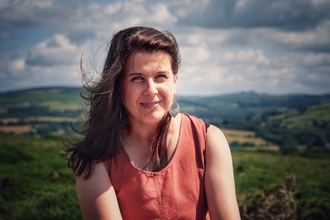Welcome back to our ‘Reading Rivers’ series, where we explore how our waterways inspire the written word. Today we’re looking at River Folk Tales of Britain and Ireland by Lisa Schneidau. First published in 2022, the book collates 32 folk tales that take place around rivers, lakes, and bogs. Now an author and storyteller, Schneidau deftly weaves in knowledge from her prior work as a river surveyor, farm advisor, and conservationist.
As you progress through the various tales, intriguing common themes emerge. One prominent idea is that of water as a catalyst for change. This is a literal metamorphosis in some cases: a woman whose grief turned her into a white trout, or a man who was cursed to become a frog. Occasionally, rivers themselves are simply the new forms of humans, giants, and spirits who – willingly or unwillingly – gave themselves to the landscape.
But more often, we see a different kind of transformation: personal growth through understanding. By taking the shapes of animals, a folk hero comes to fully know the rivers of Ireland. A druid fails to steal knowledge from a magical salmon, only to find that the pursuit has given him true wisdom. A baron schemes to stop his son from marrying a commoner, but learns his lesson when water brings them back together.
Not all of the encounters are so positive – crossing rivers can be dangerous, and these physical boundaries are often linked with supernatural ones. A simple stream becomes a place where two worlds meet; a space in which otherworldly beings can lead you astray. For the fortunate, this might be benign: one man returns safely from a party with bog fairies, while another’s eel skin braces just pull him into pubs.
Less lucky individuals might find themselves “pixy-led” into perilous situations. A farm hand vanishes after following the voice that calls from a nearby river. A drunken husband is lured to a soggy death by will-o-the-wisps that he mistakes for lanterns. A traveller finds a bridge blocked by a pixy, and only stuffing him into her basket – while studiously ignoring his distracting chatter – allows her to cross the river safely.
These darker tales remind us of the inherent danger of watercourses, but also of the awe they can provoke in us. The rising of the River Misbourne – a rare winterbourne chalk stream – foretells a series of national tragedies. A girl dies after slipping on a river rock, and her ghost marks the anniversary by causing deadly “accidents”. This unease can also take a monstrous form, manifesting as worms, dragons, merfolk, and boggarts.
There is the afanc, which causes destructive flooding; the Knucker Dragon, which scoops up livestock “like a toad licks flies off a river stone”; and the Lambton Worm, which steals milk from cows and taints the river. When land drainage destroys his bog, Tiddy Munn goes from a helpful spirit to one that ruins crops, spreads illness, and drowns dyke-diggers – only symbolic offerings of water can appease his anger.
The most famous figure is undoubtedly the kelpie: a “water horse” with backwards hooves and a mane of writhing snakes. In one tale, not even a locked chapel door can keep a kelpie from its victim. In another, a woman meets a handsome man while washing clothes in a river – a crafty kelpie in disguise. Like many of the book’s fearsome foes, only the most cunning heroes have a chance of defeating them.
If the stories we tell reflect our hopes, our fears, and the lessons we’ve learned, what can we conclude from these fantastic folk tales? This is the question that Schneidau ponders in her thoughtful introductions to each story and chapter. Her commentary provides context about the plants, animals, habitats, and history, but also highlights what we’ve lost to pressures like sewage, farming, abstraction, and industry.
Some of the stories in this book are hundreds of years old. The relationship between people and rivers is even older. Yet there is still a tension between our desire to shape them for our benefit, and their natural tendency to return to a wilder state. We have the knowledge to tackle this, Schneidau notes, but do we have the will? With their respect for the power of nature, we could learn a lot from a folk tale or two.
Overall, this book is an absorbing dive into what rivers mean to us, and a testament to the enduring power of a good story. You can borrow printed and e-book copies from your local Hampshire library, so grab your free library card today! You can also hear from Lisa Schneidau at our Tales from the Riverbank Literature Festival this June. This project is part of the Watercress and Winterbournes scheme.


